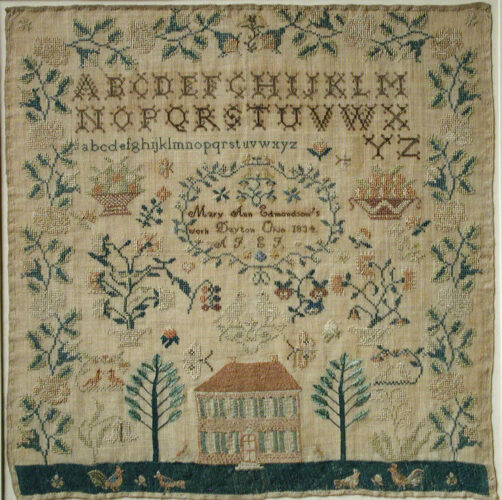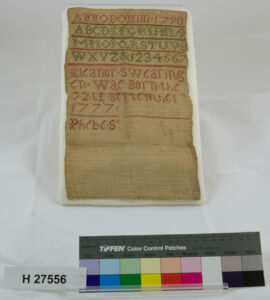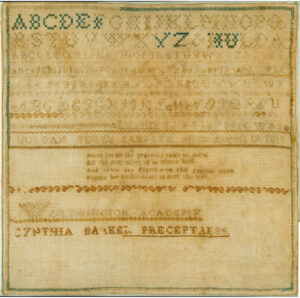“When This You See, Remember Me:” Needlework Samplers in Ohio Memory

Full cross. Half- and quarter-cross. Eyelet. Smyrna cross. Satin stitch. Maybe you’re reading these and thinking “what in the world?” Centuries of young girls, however, understood this language perfectly. It’s the language of needle, thread, and fabric, and of the samplers in Ohio Memory.
For a genteel young girl, samplers performed multiple functions. At its most basic, a sampler was a work product, a tool on which a girl practiced her stitch work, but a sampler could also be a work of art and a record of a moment in a girl’s life. Thus, through sampler work, the girl showed training in domesticity as well as an ability to combine color and shape to create a product that was aesthetically pleasing, announcing to the world, “I was here!”

Ten-year-old Mary Jane Woods of Geauga County created this sampler in 1837. Again, we see the house motif, but we also see a variety of lettering and at least two stitch variations: cross stitch and eyelet. Though she could not have known at the time, her sampler is also valuable to historians due to its biographical information on both Mary Jane and on the school in which she learned needle arts: the Sarah A.M. Ensign Institute. Researchers have not found any documentation on Ms. Ensign’s institute and, in fact, she may have taught out of her home. Genealogical research indicates that she was probably 25 years old at the time and not yet married, so perhaps she sought to earn a bit of her own money while still single. Meanwhile, Mary Jane went on to marry a man with the last name of Sturdevant and then taught for twenty years in Stow, Ohio.

At thirteen, Eleanor Swearingen may not have had the patience, or interest, to complete her sampler. She provided her name, date of birth, and the year in which she began her work, along with one alphabet. Her sampler features more than one lettering style and more than one stitch type, but the sampler makes us wonder: did the future Mrs. Thomas Worthington foresee a life in which she would be too busy for quiet needlework? Or, as the oldest daughter of a widowed father, was she already too busy helping him run the house? No matter the case, this sampler points to a moment in the childhood of an early First Lady of Ohio. In a funny twist, a sampler stitched by a daughter – probably Margaret – of Eleanor Swearingen Worthington can also be seen in Ohio Memory…and, like her mother’s, this one is also incomplete.
If your interest has been piqued, there are several other 19th-century samplers available for viewing through Ohio Memory: Mary Ann Edmondson; Huldah Bull; Marian Edison; Louisa (last name illegible); and Anna Ladd. And, if you’re so inspired, many modern needlework designers offer reproduction sampler charts for sale. All you need is a needle, floss, even-weave fabric, and time, and you can create a record for future generations to cherish.
Thank you to Shannon Kupfer-Trausch, Digital Initiatives Librarian at the State Library of Ohio, for this week’s post!



Leave a Reply
You must be logged in to post a comment.